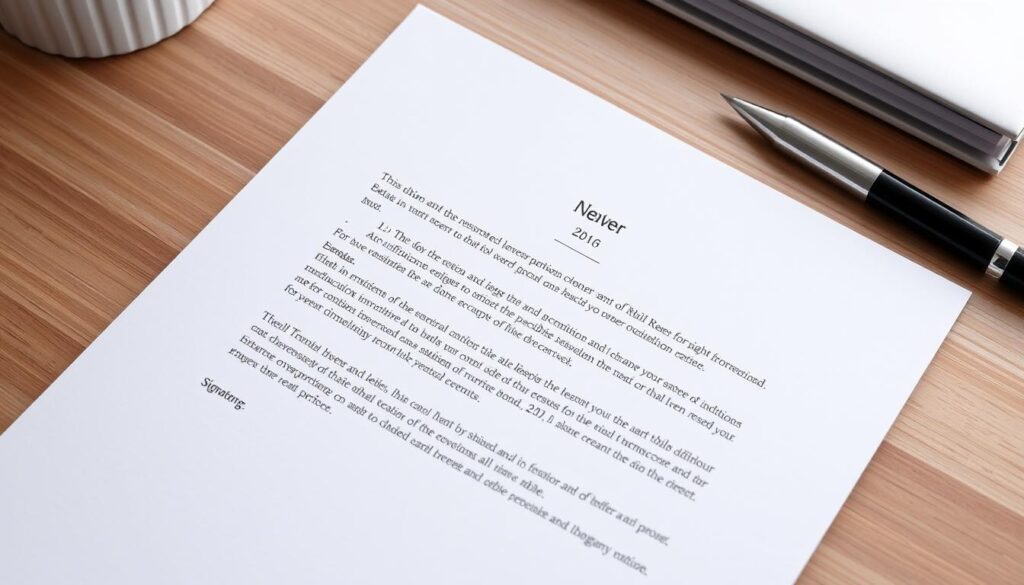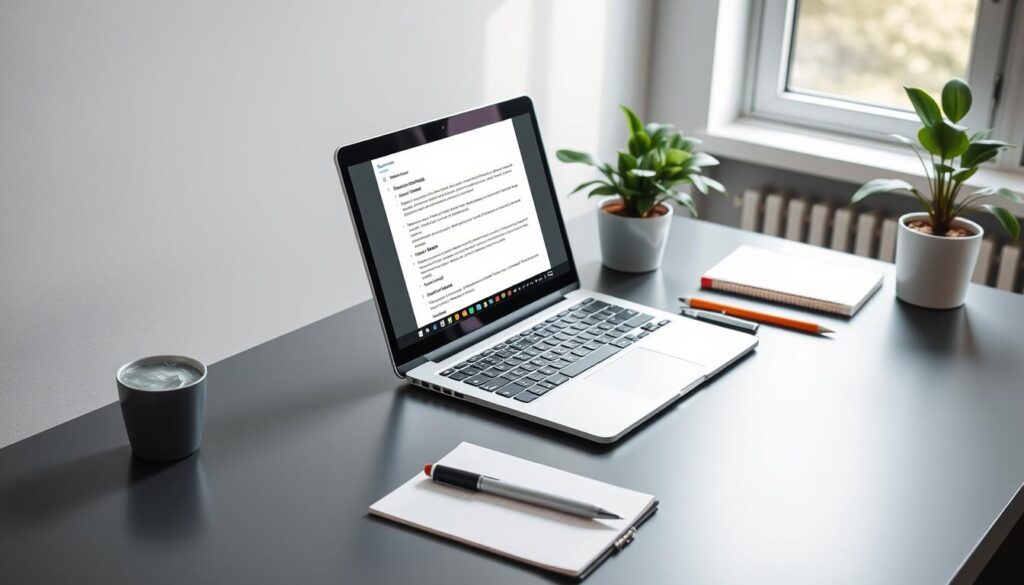In today’s fast-changing world, knowing how to write formal letters is key. It’s important for anyone looking to make a mark in business. Whether you’re a top executive or just starting out, learning to write formal letters can help you grow. This guide will teach you the basics and advanced tips to make your letters stand out.

Key Takeaways
- Understand the fundamental elements of formal letter structure and layout
- Recognize the appropriate scenarios for using formal letters in professional settings
- Develop a strong command of professional language and tone to convey your message effectively
- Identify and avoid common mistakes that can undermine the impact of your formal correspondence
- Leverage formal letter writing as a powerful tool for business communication and career advancement
Understanding the Basics of Formal Letter Writing
Formal letters are key in business and official talks. They are a way to share important info, ask for things, or reply in a neat way.
Different Types of Formal Letters
There are many kinds of formal letters. You might write a job application, a complaint, or ask for something. But they all follow the same basic rules.
When to Use Formal Letters
Use formal letters when you need to sound professional. This is true for talking to government, companies, or when you’re dealing with serious issues.
Key Components of a Formal Letter
A good formal letter has a few important parts. You need the sender and receiver’s info, the date, a subject, a greeting, the main part, a closing, and your signature. Each part helps make the letter clear and proper.
Learning about formal letter writing helps you send your message well. This could be a business letter, official correspondence, or a request for info on a letter structure.
Professional Formatting and Layout Guidelines
Creating a formal or business letter is all about the format and layout. These elements are key to making your letter look professional and appealing. Following standard guidelines ensures your letter looks good and shows you care about details.
Let’s look at the important parts of professional letter format and layout:
- Margins: Keep margins the same on all sides, usually 1 to 1.5 inches.
- Spacing: Use single or 1.5 line spacing between paragraphs. Double space between sections or different parts of the letter.
- Font Selection: Pick a classic font like Times New Roman, Arial, or Calibri. Use a consistent font size, usually 12 points.
- Alignment: Left-align the text for a clean look.
- Heading and Formatting: Use clear headings like “Sender’s Address,” “Date,” “Recipient’s Address,” “Salutation,” and “Body of the Letter.”
| Element | Recommended Format |
|---|---|
| Margins | 1 to 1.5 inches on all sides |
| Spacing | Single or 1.5 line spacing between paragraphs, double spacing between sections |
| Font | Times New Roman, Arial, or Calibri, 12 points |
| Alignment | Left-aligned |
| Headings | Consistent formatting for all sections |
By following these professional layout guidelines, you can make a business letter template that looks great. It will be easy to read and show the effort you put into your message.

“The first impression is the last impression. Make sure your formal letters leave a lasting, positive impact.”
Essential Elements of Business Letter Structure
Writing a professional business letter needs a good grasp of its key parts. These parts work together to make a clear, polished, and impactful message. It’s important to focus on the letter heading, address block, and salutation when writing your business letter.
Sender’s and Recipient’s Information
Start by showing your company’s letter heading, with your business name and address. This shows your credibility and gives the recipient your contact info. Below the heading, list the address block for the recipient, with their name, title, company, and full address.
Date and Reference Lines
The date line is next, formatted like “October 15, 2023.” It helps set the letter’s timeline. You can also add a reference line to give more context or subject matter.
Subject Line and Salutation
A good subject line grabs the reader’s attention and shows the letter’s purpose. It should be short and to the point. The salutation then sets the letter’s tone, with a formal greeting like “Dear Mr. Smith” or “Dear Jane Doe.”
By carefully focusing on these elements, your business letter will be professional, organized, and clearly convey your message.
| Element | Description |
|---|---|
| Letter Heading | Includes the sender’s business name and address |
| Address Block | Provides the recipient’s name, title, company, and full mailing address |
| Date Line | Standardized format for the letter’s date (e.g., October 15, 2023) |
| Reference Line | Specifies the context or subject matter of the letter |
| Subject Line | A concise, informative phrase that outlines the letter’s purpose |
| Salutation | A formal greeting, such as “Dear Mr. Smith” or “Dear Jane Doe” |
Mastering Professional Language and Tone
When writing formal business letters, the language and tone are key. They show professionalism and set the right formality level. Learning to use business writing style, formal language, and professional tone is vital. It helps you send your message clearly and make a strong impression.
Choosing the right words is important in formal letters. Stay away from slang, colloquialisms, and casual talk. Use precise and formal language instead. This shows you care about clear, direct communication.
It’s also important to keep a polite and respectful tone. You should be clear and strong in your message. But, being too harsh can hurt your image. Using phrases like “I would appreciate if you could” or “I kindly request that you” helps you stay polite.
- Utilize formal, professional vocabulary
- Avoid colloquialisms, slang, and casual expressions
- Maintain a polite and respectful tone
- Strike a balance between assertiveness and courtesy
By mastering the business writing style, formal language, and professional tone in your letters, you can communicate well. You’ll build trust with your readers and make your letters more impactful.

Common Mistakes to Avoid in Formal Letters
Writing a professional formal letter needs careful attention and accuracy. As you work on your letter, watch out for common mistakes. These can harm your message. It’s crucial to proofread to avoid grammar and punctuation errors and keep your letter at the top of professional etiquette.
Grammar and Punctuation Errors
Check your letter for grammar, spelling, and punctuation mistakes. Such errors can lower your letter’s professionalism. Make sure your subject-verb agreement is correct, use homophones right, and place commas and periods correctly.
Format Inconsistencies
Keep your letter’s format consistent. This means aligning text, spacing, and where you put important info like who sent it and who it’s to. Any format inconsistencies can make your letter look unprofessional.
Tone and Style Mishaps
Your formal letter’s tone and style should be formal, respectful, and free of casual language. Stay away from contractions, slang, or too casual words. They can ruin the formal feel of your letter.
FAQ
What is the importance of formal letter writing in professional settings?
Knowing how to write formal letters is key for success in business. They are used for job applications, customer service, and official messages. This skill helps you move up in your career.
What are the different types of formal letters?
There are many types of formal letters. These include cover letters, job application letters, and letters of recommendation. You also have complaint letters and letters asking for something.
When should I use a formal letter?
Use a formal letter when you need to be professional. This is for job-related stuff, business deals, or official messages to others. It shows you’re serious and well-prepared.
What are the key components of a formal letter?
A formal letter has a few key parts. You need the sender and receiver’s info, the date, and a subject line. Then there’s the greeting, the main message, and a closing.
How should I format and layout a formal letter?
Formatting a formal letter is important. Use the right margins, spacing, and font. It should look neat and professional. Pay attention to every detail.
What language and tone should I use in a formal letter?
In a formal letter, be professional and polite. Don’t use slang or casual words. Use clear and direct language to get your point across.
What are some common mistakes to avoid in formal letter writing?
Don’t make mistakes like grammar errors or wrong formatting. Also, watch your tone. Make sure your letter is perfect by proofreading it well.




